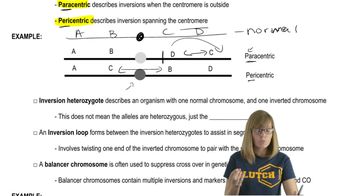Table of contents
- 1. Introduction to Genetics51m
- 2. Mendel's Laws of Inheritance3h 37m
- 3. Extensions to Mendelian Inheritance2h 41m
- 4. Genetic Mapping and Linkage2h 28m
- 5. Genetics of Bacteria and Viruses1h 21m
- 6. Chromosomal Variation1h 48m
- 7. DNA and Chromosome Structure56m
- 8. DNA Replication1h 10m
- 9. Mitosis and Meiosis1h 34m
- 10. Transcription1h 0m
- 11. Translation58m
- 12. Gene Regulation in Prokaryotes1h 19m
- 13. Gene Regulation in Eukaryotes44m
- 14. Genetic Control of Development44m
- 15. Genomes and Genomics1h 50m
- 16. Transposable Elements47m
- 17. Mutation, Repair, and Recombination1h 6m
- 18. Molecular Genetic Tools19m
- 19. Cancer Genetics29m
- 20. Quantitative Genetics1h 26m
- 21. Population Genetics50m
- 22. Evolutionary Genetics29m
6. Chromosomal Variation
Chromosomal Rearrangements: Inversions
Problem 22a
Textbook Question
A couple planning their family are aware that through the past three generations on the husband's side a substantial number of stillbirths have occurred and several malformed babies were born who died early in childhood. The wife has studied genetics and urges her husband to visit a genetic counseling clinic, where a complete karyotype-banding analysis is performed. Although the tests show that he has a normal complement of 46 chromosomes, banding analysis reveals that one member of the chromosome 1 pair (in group A) contains an inversion covering 70 percent of its length. The homolog of chromosome 1 and all other chromosomes show the normal banding sequence. Would you advise the woman that she will have to bring each pregnancy to term to determine whether the fetus is normal? If not, what else can you suggest?
 Verified step by step guidance
Verified step by step guidance1
Understand the genetic condition: The husband has a chromosomal inversion on one of his chromosome 1 pair, which can lead to complications during meiosis and potentially result in unbalanced gametes.
Consider the implications of the inversion: Inversions can lead to the production of gametes with duplications or deletions if crossing over occurs within the inverted segment during meiosis.
Explore genetic counseling options: Genetic counseling can provide information on the risks of having a child with genetic abnormalities due to the inversion.
Discuss prenatal testing: Suggest options such as amniocentesis or chorionic villus sampling (CVS) to detect chromosomal abnormalities in the fetus early in the pregnancy.
Consider preimplantation genetic diagnosis (PGD): If the couple is open to assisted reproductive technologies, PGD can be used to select embryos without chromosomal abnormalities before implantation.
Recommended similar problem, with video answer:
 Verified Solution
Verified SolutionThis video solution was recommended by our tutors as helpful for the problem above
Video duration:
6mPlay a video:
Was this helpful?
Key Concepts
Here are the essential concepts you must grasp in order to answer the question correctly.
Chromosomal Inversions
A chromosomal inversion occurs when a segment of a chromosome is reversed end to end. This can disrupt gene function and may lead to reproductive issues, such as miscarriages or congenital abnormalities. In this case, the husband's chromosome 1 has a significant inversion, which could affect the viability of embryos and the health of potential offspring.
Recommended video:
Guided course

Inversions
Karyotype Analysis
Karyotype analysis is a laboratory technique that visualizes an individual's chromosomes to assess their number and structure. It helps identify chromosomal abnormalities, such as duplications, deletions, or inversions. In this scenario, the normal karyotype indicates that the husband has the typical number of chromosomes, but the inversion on chromosome 1 is a critical finding that may influence genetic counseling and reproductive decisions.
Recommended video:
Guided course

Chi Square Analysis
Genetic Counseling
Genetic counseling is a process that provides individuals or couples with information about genetic conditions and the risks of passing them on to their children. It involves assessing family history, discussing potential genetic tests, and exploring reproductive options. Given the husband's chromosomal inversion and the family's history of stillbirths and malformations, genetic counseling can help the couple understand their risks and make informed decisions about family planning.
Recommended video:
Guided course

Descriptive Genetics
Related Videos
Related Practice



